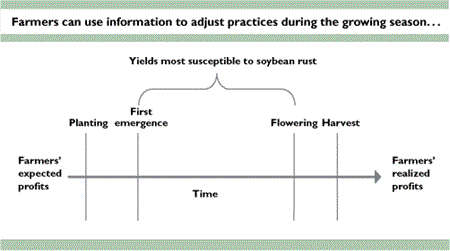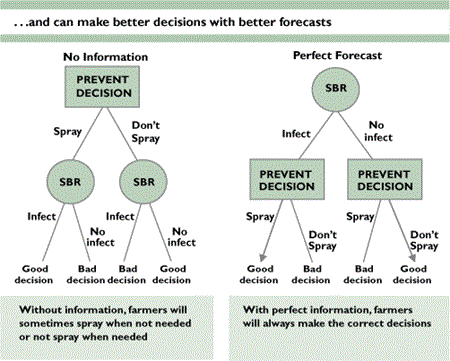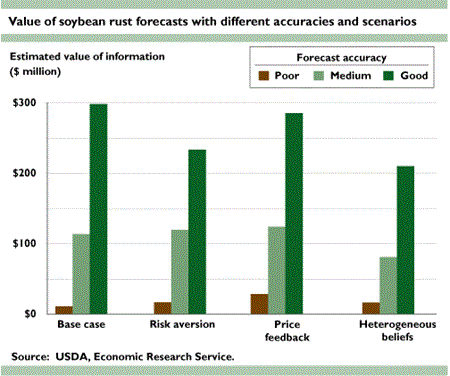Public Information Creates Value

Highlights:
-
With accurate information, individuals can make sound decisions that allow them to adjust their actions to the situation at hand. Information comes from many sources, but the value of publicly provided information is often underestimated.
-
For farmers who are trying to react to a potential pest infection, such as soybean rust, information about the likelihood of infection can help them to make better decisions about the amount and timing of fungicide applications, which will ultimately increase their profits.
Soybean rust (SBR), which is believed to have been transmitted to the United States on the winds of hurricanes during the summer of 2004, is a new pest threatening the U.S. soybean crop. In response to this threat, USDA leads an initiative to monitor outbreaks of SBR and provide real-time forecasts of its spread to help farmers efficiently apply preventative and curative fungicides. In 2005, SBR turned out to be less damaging than expected, which led some to question whether or not development of the initiative was worthwhile. But ERS research finds that the public information about SBR was still quite valuable because it helped farmers make better decisions in managing their operations. In general, the more information influences decisions, the greater its value. Although the precise value of the SBR information is unclear, with estimates ranging broadly from $11 million to $299 million in 2005, even the lowest estimated value is several times the costs of providing the information to farmers.
Information is an unusual kind of economic good. It is not bought and sold in stores like apples, cars, or DVD players, mainly because people can easily share or replicate information. As a result, markets do not always create and disseminate information as efficiently as other kinds of goods and services because it is hard for businesses to control access and charge all users. Sometimes the government can step in and provide information, like hurricane or crop forecasts, that private markets do not provide.
USDA and other agencies also implement regulations that create incentives for individuals and businesses to provide information they otherwise may not. For example, the Food and Drug Administration (FDA) requires “Nutrition Facts” labels on food products, which helps consumers make better dietary choices. These examples are a few of the many ways government influences the creation and dispersal of information.
Information is not normally traded in competitive markets like apples. Thus, quantifying its value is difficult because it involves determining the decisions farmers would have made without the information and what the consequences of those decisions would have been. ERS estimated the value of public information from USDA’s SBR initiative by comparing farmers’ expected profits, as viewed from the beginning of the season, with and without the information. The value reflects the degree to which information allows farmers to adjust their decisions to suit the particular situation at hand. Estimating the value involves quantifying how large a threat farmers would have perceived SBR to have been without the real-time forecasts. It also involves evaluating what farmers’ decisions and profit outcomes would have been without the framework.
The Soybean Rust Coordinated Framework
In 2005, USDA initiated the Soybean Rust Coordinated Framework to track and forecast the incidence and spread of a new pest threatening the U.S. soybean crop: Phakopsora pachyrhizi, a fungus with the common name soybean rust. SBR has been a recurrent problem for soybean producers in much of the southern hemisphere. In recent years, SBR has reduced yields and raised production costs for soybeans in every major production region of the world except the United States. Although SBR has the potential to cause significant yield losses, these can be almost entirely mitigated with application of fungicides. The fungicides, however, are expensive, so application reduces farmers’ profits if SBR does not occur.
Almost 60 percent of the U.S. soybean crop is produced in areas where climatic conditions are expected to support establishment of SBR in at least 5 of 10 years. SBR was first detected in the Southern U.S. in fall 2004, late enough in the season that it posed no threat to that year’s soybean crop. After overwintering in the South, SBR posed a new, uncertain, and potentially large threat at the beginning of the 2005 U.S. soybean season. Fields infected with SBR were anticipated to see markedly reduced soybean yields if not treated with fungicides.
With sufficient notice of an SBR threat, farmers could treat their fields in advance with preventative fungicides. Another approach to the threat was to carefully monitor fields and immediately treat with curative fungicides once the disease was detected. Because curative fungicides must be applied immediately after first infection, this approach also benefits from timely information on the spread of SBR by allowing farmers to limit scouting to times when infection risks are highest. Fungicides are costly, and the efficacy of both preventative and curative fungicides is sensitive to the timing of application, which means that better information about the likelihood of infection helps farmers improve management decisions and increase profits.
Information collected and analyzed by the framework is communicated to the public via the website, www.sbrusa.net. The public website includes a regularly updated map showing where field and test-plot monitoring has found and not found evidence of SBR; national and local commentary discussing the incidence and likely spread of SBR; and management strategies, often delineated by county. The framework also uses a web-based system to facilitate communication between the many experts, comprised from government and nongovernment agencies and universities, who monitor for SBR in soybean fields and sentinel plots strategically located throughout the country. USDA built and tested the new information infrastructure before SBR had caused any significant U.S. crop losses.
The website, which was updated almost daily during the growing season, was viewed about 4.9 million times in 2005. Approximately 4,500 users of USDA’s SBR Internet website signed up to be alerted via email when new information, such as new incidence of SBR in the U.S., was posted. This was the broadest USDA delivery over the Internet of an information system to provide pest forecasts to farmers and other stakeholders.
Estimating the Value of Soybean Rust Forecasts
How valuable is information provided by the framework? This question has become particularly salient in light of the modest outbreak of SBR during the 2005 season. Given the expense of developing the website and its underlying infrastructure, some have questioned whether the infrastructure was a worthwhile endeavor. After all, if some farmers had simply managed their crops as if there were no SBR threat, it is possible that they would have fared as well as or better than they actually did in 2005.
This view overlooks the widespread perception that SBR posed a threat (of unknown magnitude) at the beginning of the season, and it is not clear how farmers might have prepared for that threat in the absence of the framework, which provided real-time information about local, more imminent threats. It could not have been known in advance that optimal conditions for infection ultimately would not arise in most areas. Indeed, without the framework, individual farmers in some areas may have incurred even greater expenses in monitoring their own fields and perhaps spraying fungicides for a threat that did not exist. Without the framework, some farmers may have forgone planting soybeans entirely and planted a less profitable alternative crop.
ERS assessed the framework’s value by estimating farmers’ expected profits, as viewed from the beginning of the growing season, with and without the information from the framework. Making this calculation involved quantifying farmers’ expectations about the likelihood of SBR at the beginning of the season—that is, how likely they perceived the SBR threat to be. It also involved evaluating what farmers’ decisions and profit outcomes would have been without the framework.
Farmers’ decisions are fundamentally different with and without information about the SBR threat. With no information (the left decision tree), farmers have to decide whether to spray or not without knowing if their fields will become infected with SBR. In this instance, farmers will sometimes spray when not needed and sometimes not spray when needed. Information about natural events will seldom be perfect, but for illustrative purposes a decision tree is shown that displays the outcome with a perfect forecast. With perfect information, farmers can always make the correct decision and have higher profits.
The ERS analysis of the value of SBR information addressed several intermediate scenarios and used decision trees that allowed for less than perfect information and a wait-and-see (monitor-and-cure) treatment option. This richer analysis allowed for sensitivity tests of the results to changes in assumptions about risk aversion, heterogeneous beliefs of farmers, and market price feedbacks from soybean yield changes (see “Different Scenarios Affect Estimated Information Values, But Not by Much”).
We examined how values might have varied over different soybean-producing regions and what the information values would have been if farmers had different expectations about the likelihood of SBR at the beginning of the season. Although pinning down a precise value is impossible, the analysis provides some perspective on the likely benefits from the publicly provided information.
Across all scenarios and forecast accuracies considered, we found the value of information from the framework to range between $11 million and $299 million in 2005, or about $0.16 to $4.12 per acre. This value is made up of a combination of reduced expected costs and higher expected yields, as viewed from the beginning of the season. The range of possible information values is small relative to total U.S. soybean sales (about $16.1 billion, or $214 per acre), but quite large relative to the cost of establishing the framework. Although we did not conduct a comprehensive cost analysis, including amortization of any fixed one-time costs, the framework’s total development cost in 2005 was $2.6 million, which suggests that the benefits of the framework exceeded its costs.
Note that forecast quality pertains to forecast accuracy, not the incidence of SBR. A poor (imprecise) forecast is one that resolves 20 percent of farmers’ uncertainty about whether or not they will be infected; medium and good (accurate) forecasts resolve 50 and 80 percent of their uncertainty.
As one would expect, accurate forecasts have much higher value than do imprecise forecasts. More surprising, perhaps, is that risk aversion (how much soybean farmers prefer steady profits over variable profits), anticipated price shocks (i.e., price feedback) from large rust outbreaks, and widely varying farmer expectations (i.e., heterogeneous beliefs) about the risk of infestation have relatively little influence on the value of information, when keeping the accuracy of the forecast fixed.
Public information has been particularly valuable for SBR management, mainly because the forecasts aided farmers in their decisions about whether or not to apply fungicides. Because of the high cost of monitoring and applying fungicides, farmers would have wanted to apply these management strategies only if an SBR threat were likely. Without a forecast, they would have been more likely to spray when it was unnecessary and not spray when it was necessary. If preventative measures had not been available and the only management options were to lose crops to infection, if infection were certain to occur, the forecasts would have had little or no value. Thus, in evaluating the cost effectiveness of developing public monitoring and forecasting services for pests other than SBR, a key feature to consider is whether or not preventative management strategies might take advantage of any information provided. The lesson learned is that the more information influences decisions, the greater its value. This is true regardless of whether information takes the form of hurricane forecasts, food nutrition labels, crop production forecasts, Internet searches, or SBR forecasts.
<a name='box'></a>Different Scenarios Affect Estimated Information Values, But Not by Much
The Base Case: The value of information is determined by estimating the increase in expected profit per acre of soybeans planted and assuming soybean prices were fixed at May 2, 2005, futures prices.
Risk Aversion: Like the base case, except farmers are assumed to be strongly risk averse, meaning they strongly prefer a steady flow of profits over one that is variable, holding expected profits the same. Risk-averse farmers are more prone to apply preventative fungicides in the absence of information. They may also derive less value from a lot of information because, somewhat counterintuitively, fine-tuning their decisions in response to information may cause their profits to be more variable, even though profits are higher on average. For example, without an accurate forecast a farmer may always apply the preventative fungicide, resulting in a steady but low level of profits. With an accurate forecast, farmers apply fungicides only when needed, leading to higher average profits but somewhat more variability. Because risk-averse farmers dislike profit variability, the information is therefore less valuable than it is to a farmer who cares only about average profits. The difference, however, is small.
Price Feedback: Like the base case, except in the event of an SBR outbreak, soybean prices adjust to the reduced supply. The price response is estimated using historical price response to local yield shocks. Because price increases offset farmers’ profit losses but hurt those who purchase soybeans, the analysis considers the total effect of information on both soybean farmers and soybean purchasers. Because prices tend to move in the opposite direction as yield shocks, these effects tend to offset each other, and thus have little overall effect on the value of information.
Heterogeneous Beliefs: Like the base case, except farmers within each region are assumed to have held widely varying expectations about the likelihood of an SBR outbreak. In this scenario, some farmers value information far more than others do, but on average, the value is close to the base case.
The Value of Plant Disease Early-Warning Systems: A Case Study of USDA's Soybean Rust Coordinated Framework, by Michael Robbins, David Schimmelpfennig, Elizabeth Ashley, Michael Livingston, Mark Ash, and Utpal Vasavada, USDA, Economic Research Service, April 2006
Economics of Food Labeling, by Elise Golan, Fred Kuchler, Lorraine Mitchell, Catherine Greene, and Amber Jessup, USDA, Economic Research Service, January 2001
Food Safety, by Sandra Hoffmann and Michael Ollinger, USDA, Economic Research Service, February 2024




